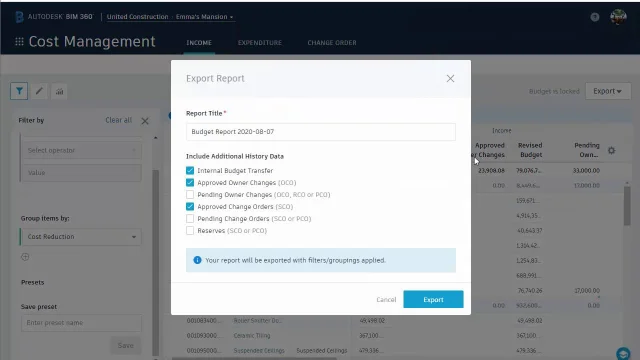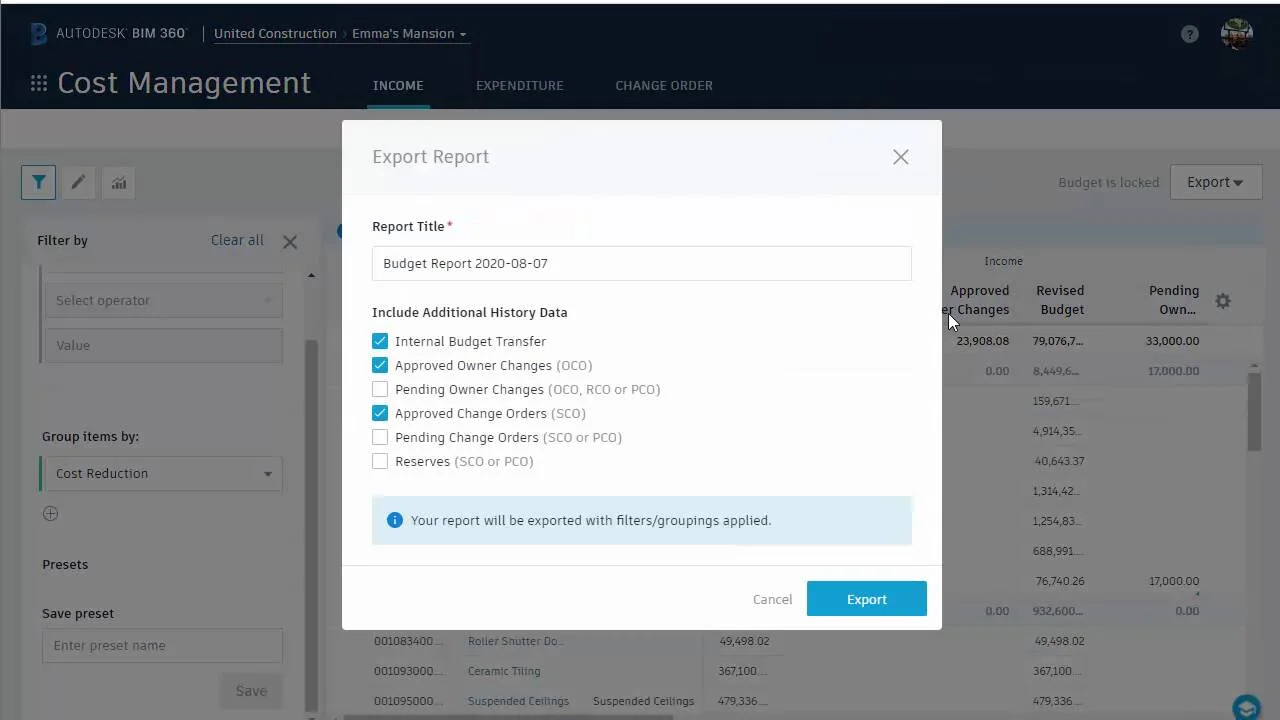Custom Attributes
Within the Budget, Cost, and Change Order tabs, you can view more information about each line item through the flyout panel. Project administrators may want to add extra attributes to the flyout panel by creating custom attributes. After the custom attribute is created, it will appear as an option in the flyout panel for the specific tab it was created for.
In this article:
- Create a Custom Attribute
- Enter Data for a Custom Attribute
- Group by Custom Attributes
- Display Custom Attributes as Columns
- Custom Attributes and Contract Types
- Use Custom Attributes - Example
Create a Custom Attribute
Project administrators are the only individuals who have permission to create and edit custom attributes. To do so, in Project Admin, select Services. You can now access the settings for the different components within Cost Management.
Custom attributes can be created in the following areas:
- Budget: Budget, Main Contract, and Budget Payment Application
- Cost: Contract and Cost Payment Application
- Change Order: Cost Item, PCO, RFQ, RCO, OCO, & SCO
To add a custom attribute:
Click Module Selector


 .
.Select the Services tab.
Select Cost Management from the left panel.
Select either the Budget, Cost, or Change Order tab.
Click Add in the custom attributes section.
Either click to add, or drag and then drop the attribute from the left sidebar into the center preview panel. Available attributes include:
- Text: Members can enter alpha-numeric text.
- Number: Members can enter numerical values.
- Date: Members can select a date from a calendar.
- Dropdown menu: Members can select from the options designated in the settings.
- Checkbox: Members can enable or disable the checkbox.

Select the attribute to define it in the properties panel on the right. The details vary depending on the selected attribute.
| Text | Number | Date | Dropdown Menu | Checkbox |
| Attribute title | Attribute title | Attribute title | Attribute title | Attribute title |
| Default value and format: Multi Line - this option lets you enter a default value that spans multiple lines of text. Rich Text - this option allows you to add formatting like bold, italics, and bullet points to a default value. Use the Rich Text option with the Multi Line option. |
Default value - you can enter a whole number or a number wit a decimal point. For example, 11,700. | Default value: None - there is no default value for a custom attribute, the words "Select Date" shows and you can choose the date from the calendar. Fixed Date - you choose the date that appears next to the attribute by default. However, you will be able to select a new date by clicking the calendar. Relative date - you can choose the adaptive date. For example, you can set the attribute to show the date one week after creating the contract - to mark the deadline. |
Options, where one option is allowed per line. | Default value - to show the checkbox custom attribute as marked or not. |
| Display in the home page - determine if the custom attribute's date should be visible in the home page. | ||||
| Visibility (show by default) - clear this option to make a custom attribute invisible in the item's detail panel. | Visibility (show by default) - clear this option to make a custom attribute invisible in the item's detail panel. | Visibility (show by default) - clear this option to make a custom attribute invisible in the item's detail panel. | Visibility (show by default) - clear this option to make a custom attribute invisible in the item's detail panel. | Visibility (show by default) - clear this option to make a custom attribute invisible in the item's detail panel. |
| Apply to Contract Type - choose which contract type this custom attribute applies to. This option is available only for contract custom attributes. Make sure you set your contract types beforehand. When a new custom attribute is added, it automatically applies to all contract types. | Apply to Contract Type - choose which contract type this custom attribute applies to. This option is available only for contract custom attributes. Make sure you set your contract types beforehand. When a new custom attribute is added, it automatically applies to all contract types. | Apply to Contract Type - choose which contract type this custom attribute applies to. This option is available only for contract custom attributes. Make sure you set your contract types beforehand. When a new custom attribute is added, it automatically applies to all contract types. | Apply to Contract Type - choose which contract type this custom attribute applies to. This option is available only for contract custom attributes. Make sure you set your contract types beforehand. When a new custom attribute is added, it automatically applies to all contract types. | Apply to Contract Type - choose which contract type this custom attribute applies to. This option is available only for contract custom attributes. Make sure you set your contract types beforehand. When a new custom attribute is added, it automatically applies to all contract types. |
- Click the attribute handlebar
 to rearrange attributes.
to rearrange attributes. - To delete an attribute, click the trash can icon.
- Click Finish to save.
After creating the custom attribute, it appears as an option in the details panel or table view.
Custom Attributes as Variables in Documents
Some custom attributes can be used in generating documents, such as change orders. Create custom variables to include your custom attributes in document templates. Not all custom attributes create custom variable entries. The following support custom variables:
- Cost contract custom attributes
- Change order custom attributes

The format for these custom attributes is {xxx.properties[“Attribute Title”]}. For example, a date custom attribute for an RFQ titled “Required on Site” would be {rfq.properties[“Required on Site”]} would return the date specified.
Copy the variable from the custom attribute edit and paste it into the desired document template.
Enter Data for a Custom Attribute
When a custom attribute has been defined in Project Admin, it is available to use in the tab it was created for.
- In Cost Management, select the tab you created the attribute for (for example, Budget) and sub-tab (for example, Main Contract).
- Click a line item to open the details panel.
- At the top of the details panel, use the drop-down list to enable the checkbox for Custom Attributes.
- Scroll to the bottom of the details panel to locate the custom attributes.
- Enter the data for each attribute.
- Close the details panel to save the data.

Group by Custom Attributes
You can group by custom attributes in the Budget, Contract, and Change Order views.
- In the Cost Management module, select the tab you created the attribute for (for example, Cost) and sub-tab (for example, Contract).
- Select the filter icon
 .
. - Click the Group Items By drop-down list and the defined custom attribute will appear in the list.
- Enter a preset name in the Save Preset section and select Save.
Display Custom Attributes as Columns
You can choose to display custom attributes as columns in the Budget, Cost, and Change Order table views.
- In the Cost Management module, select the desired tab (for example, Budget) and sub-tab (for example, Main Contract).
- Select settings
 .
. - Select the checkboxes next to the custom attributes that you want to display as a column in the table view.
Custom Attributes and Contract Types
Contract custom attributes can be configured to apply to specific contract types. This allows you to tailor which custom attributes are relevant for different kinds of contracts in your project.
When you create or edit a contract custom attribute, you can select which contract types it applies to using the Apply to Contract Type drop-down list. By default, new custom attributes apply to all contract types.
To configure which custom attributes apply to contract types, see Contract Types in the Cost settings.
How Contract Types and Custom Attributes Interact?
The settings for contract types and custom attributes influence each other:
- If you clear a custom attribute for a contract type, that type will be automatically deactivated in the custom attribute settings as well.
- If you deactivate a contract type, it will be hidden from the custom attribute settings.
- If you delete a contract type, it will be removed from all custom attribute settings.
When you change which contract types a custom attribute applies to, existing data may become invalid if a contract's type no longer matches the custom attribute configuration.
Not Applicable and Invalid Custom Attributes
When working with contracts, you may encounter custom attributes in two states:
- Not Applicable (N/A): The custom attribute doesn't apply to the contract's current type. These appear dimmed in the table view.
- Invalid: A value exists in the custom attribute, but the attribute no longer applies to the contract's type (for example, if the contract type changed or the custom attribute configuration was modified). Invalid values appear dimmed and cannot be modified.
Viewing and Managing Non-Applicable Attributes
In the contract details flyout panel, the Custom Attributes section provides options to manage these attributes:
- Show N/A custom attributes: Click this button to display all custom attributes, including those that don't apply to the current contract type.
- Hide N/A custom attributes: Click this button to hide custom attributes that aren't applicable to the contract type.
- Clear invalid data: Click this link next to an invalid custom attribute to remove the value. A tooltip explains: "The custom attribute cannot be modified because it no longer applies to the current type."
- Clear all invalid data: Click this button to remove all invalid custom attribute values at once.

Use Custom Attributes - Example
You can use a combination of custom attributes and filtering to access specific items in your budget, contracts, or change orders. Custom attributes can be created for the different areas of Cost Management. In this example we create a custom attribute Diversity Tracking and assign values to contracts:
- Click


 .
. - Select the Cost tab, and then the Contract tab.
- Click the settings gear icon
 .
. - Choose Diversity Tracking (substitute with your own custom attribute).
- Click the filter icon
 .
. - Select Diversity Tracking in the group items by section.
This short video shows how to add new custom attribute and assign values to contracts:


